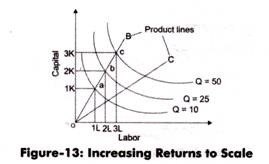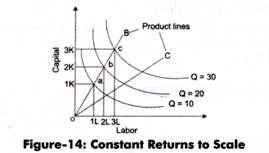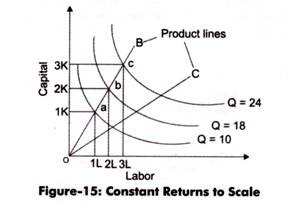Introduction:
The laws of returns to scale is explained in
terms of the isoquant approach and operates in long run. It tries to establish
the relationship between the inputs and outputs in the long run.
The law of returns to
scale explains the proportional change in output with respect to proportional
change in inputs.
In other words, the
law of returns to scale states when there are a proportionate change in the
amounts of inputs, the behavior of output also changes.
The degree of change
in output varies with change in the amount of inputs. For example, an output
may change by a large proportion, same proportion, or small proportion with
respect to change in input i.e. labor and capital.
On the basis of these
possibilities, law of returns can be classified into three categories:
i. Increasing returns
to scale
ii. Constant returns
to scale
iii. Diminishing
returns to scale
1. Increasing Returns to Scale:
If the proportional change in
the output of firm is greater than the proportional change in inputs, the
production is said to be in increasing returns to scale. For example, to
produce a particular product, if the quantity of inputs is doubled and the
increase in output is more than double, it is said to be an increasing returns
to scale. When there is an increase in the scale of production, the average
cost per unit produced is lower. This is because at this stage a firm enjoys
high economies of scale.
In Figure-13, a
movement from a to b indicates that the amount of input is doubled. Now, the
combination of inputs has reached to 2K+2L from 1K+1L. However, the output has
Increased from 10 to 25 (150% increase), which is more than double. Similarly,
when input changes from 2K-H2L to 3K + 3L, then output changes from 25 to
50(100% increase), which is greater than change in input. This shows increasing
returns to scale.
2. Constant Returns to Scale:
The production is said to
generate constant returns to scale when the proportionate change in input is
equal to the proportionate change in output. For example, In Constant returns
to scale, when inputs are doubled, outputs are also doubled.
In Figure-14, when there is a
movement from a to b, it indicates that input is doubled. Now, when the
combination of inputs has reached to 2K+2L from IK+IL, then the output has
increased from 10 to 20.
Similarly, when input changes
from 2K+2L to 3K + 3L, then output changes from 20 to 30, which is equal to the
change in input. This shows constant returns to scale. In constant returns to
scale, inputs are divisible and production function is homogeneous.
3. Diminishing Returns to Scale:
Diminishing returns to scale
refers to a situation when the proportionate change in output is less than the
proportionate change in input. For example, when capital and labor is doubled
but the output generated is less than doubled, the returns to scale would be
termed as diminishing returns to scale.
In Figure-15, when the
combination of labor and capital moves from point a to point b, it indicates
that input is doubled. At point a, the combination of input is 1k+1L and at
point b, the combination becomes 2K+2L.
However, the output
has increased from 10 to 18, which is less than change in the amount of input.
Similarly, when input changes from 2K+2L to 3K + 3L, then output changes from
18 to 24, which is less than change in input. This shows the diminishing
returns to scale.
Adopted from: https://www.yourarticlelibrary.com/economics/the-laws-of-returns-to-scale-production-function-with-two-variable-inputs-with-diagram/28643







0 Reviews:
Post a Comment